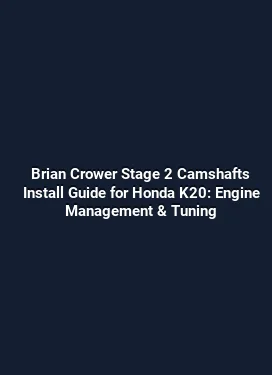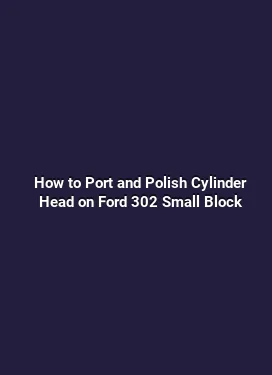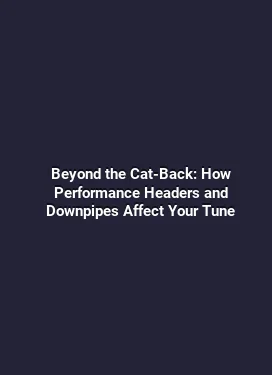How to Install ARP Head Studs on Subaru EJ257 Engine Properly
Upgrading to ARP head studs is a common and effective way to improve the reliability of high-performance Subaru EJ257 engines. This upgrade helps maintain head gasket integrity under higher cylinder pressures, especially in tuned or endurance driving scenarios. The EJ257, known for its strong internals and torque-rich performance, benefits from a precise installation process that respects the engine’s design and the ARP hardware’s requirements. The following guide provides a comprehensive, practice-oriented approach to selecting components, preparing the engine, performing the installation, and validating the results through careful testing and maintenance.
Choosing the Right ARP Head Stud Kit for the EJ257

Before any disassembly begins, selecting the appropriate ARP head stud kit is essential. ARP offers several head stud options, including multi-layer steel (MLS) gasket compatibility and different stud materials and coatings. For the EJ257, the kit should include studs, nuts, washers, and torque-to-yield (TTY) compatibility where applicable. Consider the following when choosing a kit:
- Material and coating: ARP typically provides high-strength bolts that resist thermal cycling and stretch. Coatings can reduce galling and ease installation.
- Thread engagement: Verify that the kit accommodates the EJ257’s cylinder head and block thread sizes, ensuring full engagement without bottoming out.
- Locking hardware: Some kits include locking nuts or a method to maintain preload during engine heat cycles. Use the kit as intended in the instructions.
- Compatibility with head gasket and coolant system: Ensure the gasket type (MLS) and any sealing hardware align with the kit’s recommendations.
Understanding these factors helps prevent installation issues that could compromise head gasket sealing or overall engine reliability under boost and high-rev conditions.
Preparation: Tools, Workspace, and Safety
Proper preparation is the foundation of a successful installation. Set up a clean, well-lit workspace with a stable surface for the engine and a dedicated area for fastener storage. The following tools and steps are essential:
- Tools: Torque wrench with a broad range (preferably 20–250 ft-lbs), micrometer, feeler gauge, standard and deep sockets, a breaker bar, a torque-angle adapter if required by the kit, and appropriate Allen or hex bits for the cylinder head bolts and valve cover hardware.
- Cleaning supplies: Degreaser, lint-free wipes, and a solvent for gasket surfaces. Cleanliness is critical to prevent debris from entering the coolant system or combustion chambers.
- Lubrication: Non-petroleum-based assembly lube or ARP-approved lubricant. Lubrication helps achieve consistent preload and prevents galling during initial torqueing.
- Alignment aids: Gasket templates or alignment pins if included with the kit, plus a thin smear of gasket sealant where recommended by the kit instructions.
- Safety: Eye protection, gloves, and a dedicated torque-angle or torque-limiting device if your kit requires angle tightening steps.
Establish a clean bench area for head bolts, studs, and nuts. Inspect the cylinder head and block threads for damage, nicks, or signs of prior cross-threading. If any thread damage is found, address it before proceeding, as damaged threads can lead to improper preload and gasket failure.
Disassembly and Inspection: Accessing the EJ257’s Cylinder Heads
Disassembly begins with the engine cooling system and top-end components. A careful approach minimizes contamination and preserves valve train components. Steps include:
- Remove intake components: Intake manifold, throttle body, and any vacuum lines or sensors interfering with head removal.
- Drain coolant and remove valve covers: Drain coolant if necessary to prevent spillage and remove valve covers to assess cam timing and lifters.
- Loosen and remove head bolts in a specified sequence: Follow the EJ257’s service manual sequence to avoid uneven clamping and potential warping of the cylinder head.
- Carefully separate the cylinder head: Use non-metallic tools for gasket surfaces if possible to avoid marring the mating surfaces. Support the head and check for straightness before placing it on a suitable surface.
With the heads removed, inspect the head gasket seats, mating surfaces, and the condition of the camshafts and valve train. Look for signs of overheating, pitting, or gasket residue that could indicate prior leakage paths. The EJ257 benefits from a meticulous cleaning of the head and block surfaces prior to the reassembly to ensure a reliable seal with the ARP studs.
Head Stud Installation: Step-by-Step Process
The core of this upgrade is the correct installation of ARP head studs. The process combines cleanliness, proper lubrication, and correct torque methodology. The general approach involves lubing studs, aligning the head, and applying a staged torque sequence that ensures an even preload distribution across the entire head gasket.
Preparation of studs and threads

Before threading the studs into the block, apply a light coat of assembly lube on the threads. This reduces friction and provides a consistent torque reading. Do not apply thick lubricants that could affect thread engagement. Confirm that the stud nuts and washers are clean and free of burrs or contamination. Inspect the stud seats for any damage that could prevent even contact with the head or block.
Installing the studs into the block
Insert each ARP stud into the corresponding thread in the engine block. Start all studs by hand to ensure they aren’t cross-threaded. Once all studs are partially seated, use a torque wrench to tighten them in a diagonal, multi-pass pattern to seat them without warping the block. Avoid aggressive tightening that could strip threads. The final torque should align with the kit’s specification, typically a staged process that increases in multiple increments to the recommended final value. Maintain a clean surface and verify that every stud sits flush with the block’s surface before moving to the head installation.
Head gasket seating and alignment
Place the head gasket onto the block with the correct orientation. Align any locating dowels or features that the gasket kit provides. Gently place the cylinder head onto the studs, ensuring it is centered and seated evenly. It is crucial that the head sits flat on the gasket to prevent uneven clamping forces, which can lead to gasket leaks under boost or high load.
NUT tightening sequence and final preload
Follow the recommended tightening sequence as specified by the ARP kit. The process generally involves a two- to three-stage torque approach, with specific attention to the diagonal progression across the head to evenly distribute preload. After achieving the target torque on all nuts, some kits call for an additional angle-tightening step to achieve the exact preload. If your kit includes angle tightening, use a torque-angle adapter and record the degree of rotation for each fastener to ensure uniform preload across all studs. Always re-check torque after the first heat cycle and again after a brief cooldown period if the kit instructs this procedure.
With the head installed and fasteners torqued, reinstall the valve covers and any removed components. Reconnect the cooling system and fueling lines, ensuring no leaks and that all sensors are properly seated. Having a clear schematic of the EJ257’s cylinder head layout helps in reassembling efficiently and reduces the risk of missed connections or incorrect routing of hoses.
Post-Installation Checks and Tuning Considerations
After assembling the engine, a series of checks ensures the installation’s success and long-term reliability. The goal is to verify proper seal, preload, and engine response before subjecting the engine to high loads or track use. Begin with static tests and then proceed to a controlled road or dyno session. Here are key checks and considerations:
- Coolant and oil levels: Confirm that both fluids are at the correct levels and free of contaminants.
- Leak inspection: Inspect for any signs of coolant or oil leaks around the head gasket and stud area after a brief idle period.
- Compression test: Perform a dry compression test to verify consistent cylinder sealing across all chambers. Look for balanced readings among cylinders.
- Dynamic testing: A controlled dyno or road run under load helps verify that the head gasket remains sealed and that there are no abnormal noises or misfires under boost.
- Tuning considerations: When increasing boost or modifying fueling and timing, monitor for signs of detonation or abnormal exhaust gas temperatures. A conservative approach with progressive tuning ensures the ARP head studs provide the intended reliability without compromising safety or engine life.
Armor against common failure modes includes ensuring proper head gasket seating, maintaining clean mating surfaces, and using the correct lubrication protocol during assembly. If a leak or pressure spike is detected during initial testing, re-check torque values and seating surfaces. Subtle deviations in torque due to thread cleanliness or lubrication can manifest as gasket seepage during high-load operation.
Practical Tips for Sustained Performance
To maximize the long-term benefits of ARP head studs on the EJ257, adopt maintenance practices that complement the hardware and the engine’s performance envelope. These practical tips help maintain head gasket integrity and overall reliability:
- Regular inspection: Periodically inspect head studs and nuts for signs of loosening, galling, or corrosion, especially after track sessions or aggressive driving cycles.
- Oil quality and cooling: Use high-quality synthetic oil and maintain a robust cooling system. Consistent oil pressure and coolants prevent excessive thermal cycling that can affect gasket seals.
- Fuel and ignition management: Keep fueling and ignition maps within safe margins during tuning to minimize detonation risk, which can compromise head gasket integrity under boost.
- Torque verification: After the first few heat cycles, verify torques in cases where the kit specifies a re-torque after initial operation. This ensures the preload remains consistent as components settle.
- Surface maintenance: Maintain clean mating surfaces whenever removing or reinstalling components to prevent contaminant intrusion into the sealing planes.
Investing time in proper installation and ongoing maintenance yields predictable, repeatable performance gains. The EJ257 platform responds well to well-executed hardware upgrades when paired with disciplined tuning and care during assembly.
Common Challenges and How to Address Them
Despite careful preparation, enthusiasts can encounter common challenges during ARP head stud installation. Recognizing these issues early helps prevent costly mistakes. Typical challenges include head warping, misalignment of studs, and inconsistent preload due to surface contamination. Address these by performing meticulous surface cleaning, using lubricants as specified by ARP, and verifying the alignment of the cylinder head before torquing. If a stud seat does not fully engage or if you observe cross-threading, halt the process, re-check the threads, and correct the path before proceeding. Thorough attention to detail reduces the risk of gasket failure and ensures reliable operation under demanding conditions.
In addition, ensure that the engine’s timing components are correctly reassembled. The EJ257’s timing relationship must be preserved to avoid valve-to-piston interference in extreme scenarios. A careful re-check of timing marks after head installation helps prevent mis-timed events that might otherwise go unnoticed until the engine is under load.
Final Considerations: Documentation and Validation
Documenting the installation process, torque values, and any deviations from standard procedures provides a reference for future maintenance or reinstallation. Maintain a log with the kit part numbers, batch numbers, torque steps, and any observed anomalies during testing. This record supports troubleshooting and resale value, and it helps ensure consistent practice should you perform future upgrades or maintenance on the EJ257.
With the installation complete, the vehicle should demonstrate improved head gasket stability during high-load operation and boosted performance without the typical risks associated with head gasket failure under pressure. The prudent combination of high-strength ARP fasteners, meticulous assembly, and controlled tuning creates a resilient platform for reliable performance gains.






